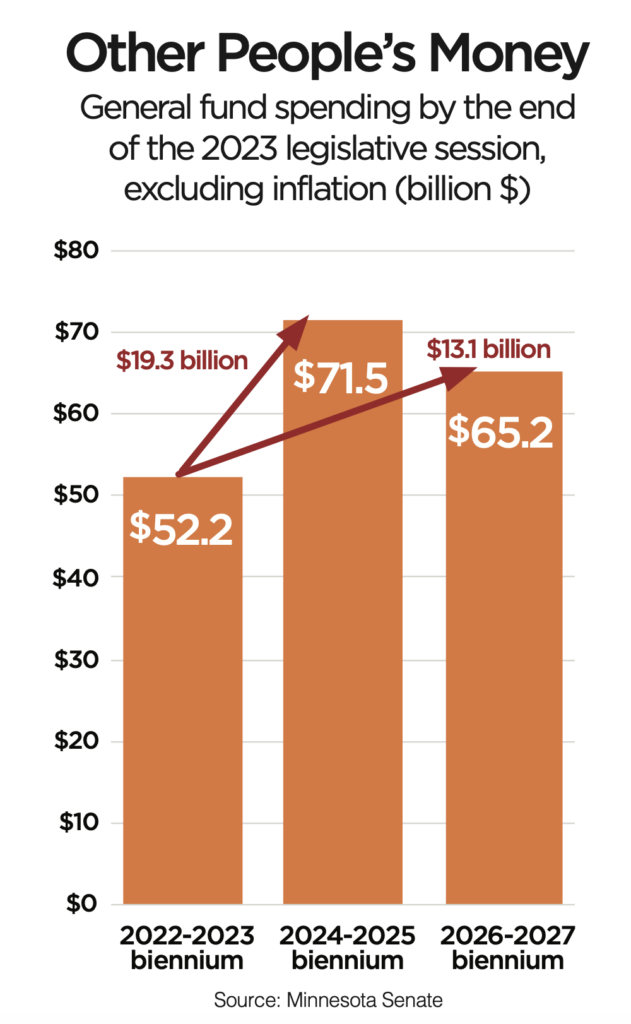Spending Spree
Where did the $18 billion surplus go?
If Minnesota’s $17.6 billion surplus were to be divided equally among all taxpayers, each would get approximately $5,800. But unless you’re a senior receiving Social Security or a low-income taxpayer, you will see your taxes go up beginning July of this year. So, what did our lawmakers do with the state’s humongous surplus?
To be clear, the legislature is giving some of that surplus back — in multiple forms. But to call it a tax cut would be a misstatement. Of the $3 billion that the DFL set aside for tax cuts, for example, $1.3 billion is for a one-time rebate check of $260 (for single filers). But only single tax filers whose income is less than $75,000 qualify.
The second component of this socalled tax cut is the new child tax credit. Again, the only way to get any money back under this credit is if you make roughly $50,000 (married and filing jointly) and $44,000 (any other filer). If you are a middle-income family, tough luck. As for taxes on Social Security, most seniors for whom this is targeted already pay no taxes on these benefits.
According to tax data, a little over one in every four Minnesota tax filers did not pay income taxes in 2018. This was because of two reasons: (1) Either tax filers made so little that they had no taxable income after counting deductions and exemptions, or (2) refundable tax credits reduced their tax liability to zero or negative, in which case they get a refund from the state government. Giving a handout to people who already pay little to no income taxes is not a tax cut.
But even if the whole $3 billion was used for actual tax cuts, that’s still less than a fifth of Minnesota’s budget surplus. Instead of giving taxpayers their money back, the DFL has used nearly the entire surplus to expand government to an unprecedented size, at the same time raising taxes by about $9 billion.

The baseline budget for the 2024-25 biennium was $55.5 billion. By the end of the session, however, the new budget has been set at a record-breaking $71.5 billion — a 29 percent increase. Compared to spending from the 2022-2023 biennium, this is nearly a 40 percent increase. Some of this money is one-time spending, but even the baseline budget in the 2026-27 biennium is $13 billion higher than what we spent in the justended biennium.
The Democrats used the surplus to expand existing programs and create new ones. For every $100 the state government spends, roughly $40 goes to E-12 education. Yet the state voted to spend billions more of the surplus on it, partly to provide free lunches to children whose families are not lacking. Welfare is also a big state expenditure, capturing nearly a third of state spending, getting over $4 billion in the next four years.
Further, legislators have voted to spend hundreds of millions to increase welfare cash benefits and make it easier for people to stay on welfare; give hundreds of millions of dollars to childcare providers; spend additional hundreds
of millions on childcare assistance; eliminate cost sharing for individuals on the state’s Medicaid program; and offer subsidized health care insurance to illegal immigrants. The North Star Promise program will provide free college to some low-income Minnesotans, including illegal immigrants. Native Americans, who already get scholarships under some programs, will get free college as well. Minnesota’s biggest grant system has been expanded, and so have other higher ed assistance programs. In housing, the state will spend hundreds of millions to hand people money for down payments and help others pay rent.
Businesses that suffered during the unrest that followed the death of George Floyd will receive hundreds of millions of taxpayer money to rebuild. The state’s paid family and medical leave will cost taxpayers over a billion dollars — just to get started. Bicyclists will get a $1,500 tax credit for electric bikes, and the Northern Express train, which is supposed to connect Duluth to the Twin Cities, will cost taxpayers $200 million. Numerous credits for businesses, like the film tax credit and Angel tax credit, have been expanded or prolonged.
Minnesotans are some of the most heavily taxed people in the United States, a factor that is largely to blame for our economy’s mediocre performance. The $18 billion surplus was a golden opportunity to change that. Instead of giving taxpayers their money back, Democrats increased the size of the government, all the while putting us on the hook for even more taxes.